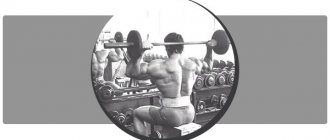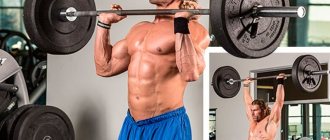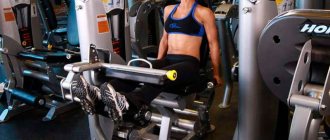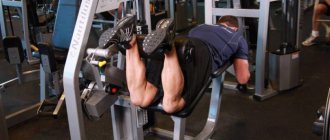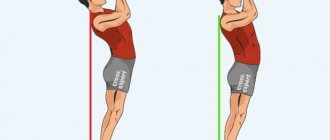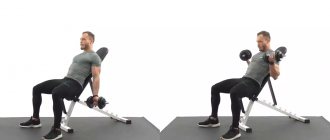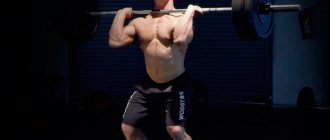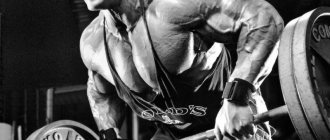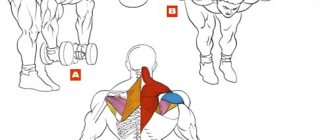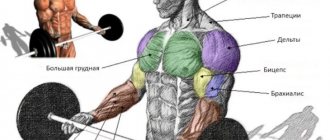Share:
What you need
- Barbell
The standing barbell press or military press is a basic exercise for developing the deltoid muscles and the overall mass of the shoulder girdle. This exercise puts the greatest stress on the shoulder muscles, which is necessary for their hypertrophy, since in a classic standing barbell press an experienced athlete can work with very decent weights, which will have a beneficial effect on increasing strength and gaining muscle mass. Just look at the world record of the Soviet weightlifter Vasily Alekseev - 235 kg! Today we will talk about how to do a standing barbell press correctly, what muscles work during this exercise and typical mistakes of beginners.
Previously, this exercise was included in the competitive weightlifting program, then athletes performed three movements: the snatch, the clean and jerk, and the standing barbell press. However, over time, the military press was excluded from competitive weightlifting due to its risk of injury and vague judging criteria - many athletes performed something between the military press and the barbell push press, but for some the movement “counted”, while others did not, and therefore they moved up a wave of misunderstandings and disputes, including in the political arena. However, to this day this exercise is widespread all over the world, and it can be seen in almost every gym on the planet, and people who are interested in CrossFit, fitness, martial arts or weightlifting devote a lot of time to the military press as part of their training process. In our article today, we will tell you how to do a standing barbell press correctly, and also delve into some of the nuances and subtleties associated with this exercise.
Today we will look at the following aspects of interest to us related to this exercise:
- What muscles work when doing a standing barbell press?
- Technique for performing the exercise;
- Typical beginner mistakes;
- CrossFit complexes containing military press.
Benefits of the Military Press
- The chest press technique allows you to focus on the work of the anterior and middle bundles of the deltoid muscle, forming a spherical shoulder shape when viewed from the front.
- The grip width allows the shoulder joints to be in a comfort zone, not too narrow and not too wide.
- The exercise can be used in training aimed at increasing muscle mass with a small number of repetitions, and for relief - honing the shape of the shoulders.
- The exercise can be performed not only standing, but also sitting, easing the load on the legs and spine, fixing the position of the back (lumbar region). This option allows you to prevent swaying, sagging of the lower back, and taking on large working weights.
- Another convenience is that the barbell can be lifted to its original position not only from the floor, but also from a power rack or performed in a simulator, without wasting additional energy and avoiding jerking movements when lifting the barbell to the chest.
Training programs
The military press is added to the beginning of shoulder training. As a rule, they are trained either on a separate day or with legs.
The most popular split programs:
| Shoulders on a separate day | |
| Exercise | Sets x reps |
| Standing barbell press | 4х15,12,10,8 |
| Seated dumbbell press | 4x12 |
| Wide grip pull | 4x12 |
| Dumbbell swings while standing to the sides | 3x15 |
| Bent over dumbbell swings | 4x15 |
| Arm raises in the rear deltoid machine | 4x15 |
| Legs+shoulders | |
| Exercise | Sets x reps |
| Squats | 4х12,10,8,6 |
| Leg press in the simulator | 3x12 |
| Bending in a lying machine | 4x15 |
| Bend one leg while standing in the simulator | 4x12 |
| Standing barbell press | 4х15,12,10,8 |
| Wide grip pull | 4x15 |
| Side bend swings | 4x15 |
Recipes for healthy eating
Smoothie with pineapple and banana
- 1.2 g Protein
- 2.7 g Fat
- 15.9 g Carbohydrates
- 92.1 kcal
5-10 min.
- #a pineapple
- #banana
- #vegetarian dish
- #water
- #dietary
- #for vegans
- #breakfast
- #drink
- #low calorie
- #dinner
- #dinner
- #fruits
Other recipes
Are there any disadvantages to the overhead press?
With the correct technique of this exercise there will be practically no possibility of injury, otherwise there is a risk of injury to the shoulder and elbow joints. The only caveat is that you need to choose the right working weight. Muscles and ligaments must be prepared for the bench press technique; compliance with this condition will allow you to gradually add working weight without damaging the ligamentous apparatus.
To a greater extent, the exercise works the shoulder in front, without including the rear delta in the work. Therefore, military bench press alone cannot create symmetrical and proportional deltoids. An important condition for training the deltoids is to perform accompanying exercises on the posterior deltoids.
Technique for performing a standing military press
- Stand in front of the barbell, place your feet hip-width apart, and grab the barbell with a grip slightly wider than shoulder-width apart.
- Stand up with a straight back, bend your elbows and lift the barbell to your upper chest (collarbone).
- Lower your elbows to the floor, do not lean your body back, hold your spine with the strength of your stabilizer muscles.
- Exhale and lift the barbell above your head, fully extending your elbows.
- As you inhale, gently lower the bar to your clavicular chest without dropping the bar.
When working for relief, perform 15-20 repetitions of 3-4 sets with a comfortable weight that will provide a strong burning sensation at the end of the set.
When working with heavy weights to increase shoulder size, perform 8 to 12 repetitions for 4 sets.
Selecting working weight.
Technique and body position are important variables in the overhead press, especially when it comes to complex standing movements. Trying to lift a weight that is too heavy can ruin your approach very quickly. With this in mind, choose circuits with a number of sets and reps that allows you to maintain correct position and technique.
For the barbell press, limit yourself to sets in the 3 to 8 rep range on your heaviest set. If you drop below 3 reps, you risk violating the optimal body position for the press. Go above 8 repetitions, and the load of fatigue will also lead to poor execution technique.
Read also: Hundred sets: full body training from Jim Stoppani.
Dumbbell and kettlebell variations may or may not be the main press, but they are always performed in a higher rep range. By doing so, you reduce the risk of technique failure and the lighter weight does not require too much from the musculoskeletal system.
Lift dumbbells and kettlebells in the 5-12 rep range. This is a sufficient range to develop strength, increase joint stability and stimulate hypertrophy.
Military bench press in a power rack
- Place the barbell in the power rack at shoulder level.
- Place your palms on the bar with a grip slightly wider than shoulder-width apart, remove the barbell and place it on your collarbone.
- Take a step back, place your feet hip-width apart.
- As you exhale, perform a full extension of the barbell overhead.
- As you inhale, gently lower to your upper chest.
- After the last rep, step forward and return the bar to the rack.
Technical aspects
The military bench press is identical to the classic bench press. Its implementation involves the pectoral muscles, shoulder girdle, and triceps.
The legs are crossed and bent at the knees, hanging, the buttocks are pressed tightly to the surface of the bench, the shoulder blades are flattened, and the chest is pushed forward.
After taking the starting position on the bench, the apparatus is grasped with both hands, providing support only with the palms. The thumbs should be on top of the projectile, the maximum permitted grip is 81 cm (see photo).
The shoulder blades are brought together and lowered towards the pelvis to increase the degree of stability, tighten the pecs and reduce the range of motion (by pushing the chest forward), pressed against the bench. The barbell is removed from the racks, the arms are extended upward perpendicular to the bench, and the elbows are fixed. The position should be such that the bar is in line with the eyes (see photo).
By bringing the chest forward, a decrease in the amplitude of movement is achieved, and the level of effectiveness of the exercise increases (see photo).
The projectile is lowered diagonally (possibly in an arc) from the level of the shoulders (upper phase) to the lower section of the pectoral muscles/solar plexus area (lower phase). Raising the projectile is identical to lowering it along the trajectory of movement (see photo).
It is better to keep the elbow joints at an angle in relation to the torso. Tight elbows will impair movement mechanics, and perpendicular abduction to the sides will create an increased risk of injury. We take care of our wrists; they should not break, otherwise the mechanics of movement will be disrupted and the risk of injury will also increase (see photo).
We inhale in the starting position, before lowering the projectile. We hold our breath. Inhalation is done through the mouth. Through deep inhalation, a rigid structure of the upper body is achieved. We exhale at the top phase of the movement.
Military press with a barbell while seated
- Sit on a bench and support (with a backrest), lift the barbell from the floor and place it above your chest with your elbows down.
- Press your lower back into the bench and perform an overhead press.
- Smoothly lower the barbell down.
- After completing the required number of repetitions, carefully straighten your elbows and lower the barbell to the floor with an inclination.
Standards[edit | edit code]
Standards of the Russian Powerlifters Union[edit | edit code]
Standing press without undergoing doping control
| Men | |||||||
| Weight category | Elite | MSMK | MS | KMS | I | II | III |
| 52 | 85 | 77,5 | 67,5 | 55 | 47,5 | 42,5 | 35 |
| 56 | 92.5 | 85 | 70 | 62,5 | 57,5 | 47,5 | 42,5 |
| 60 | 100 | 90 | 80 | 67,5 | 62,5 | 55 | 50 |
| 67,5 | 107,5 | 100 | 87,5 | 75 | 67,5 | 62,5 | 55 |
| 75 | 115 | 110 | 95 | 80 | 72,5 | 67,5 | 60 |
| 82,5 | 122,5 | 115 | 102,5 | 85 | 77,5 | 70 | 62,5 |
| 90 | 135 | 125 | 110 | 92,5 | 80 | 75 | 67,5 |
| 100 | 157,5 | 140 | 122,5 | 105 | 87,5 | 82,5 | 75 |
| 110 | 165 | 152,5 | 130 | 112,5 | 100 | 92,5 | 82,5 |
| 125 | 177,5 | 162,5 | 140 | 120 | 112,5 | 100 | 92,5 |
| 140 | 187,5 | 170 | 152,5 | 135 | 122,5 | 107,5 | 100 |
| 140+ | 195 | 177,5 | 160 | 142,5 | 135 | 122,5 | 105 |
| Women | |||||||
| Weight category | Elite | MSMK | MS | KMS | I | II | III |
| 52 | 65 | 57.5 | 52.5 | 40 | 35 | 32.5 | 27.5 |
| 60 | 72.5 | 65 | 60 | 47.5 | 40 | 35 | 32.5 |
| 67.5 | 77.5 | 72.5 | 65 | 57.5 | 45 | 40 | 37.5 |
| 75 | 95 | 77.5 | 72.5 | 62.5 | 52.5 | 47.5 | 45 |
| 75+ | 107.5 | 95 | 77.5 | 67.5 | 62.5 | 57.5 | 52.5 |
Standing press with doping control
| Men | |||||||
| Weight category | Elite | MSMK | MS | KMS | I | II | III |
| 52 | 75 | 67,5 | 55 | 45 | 40 | 30 | 27,5 |
| 56 | 82,5 | 75 | 60 | 52,5 | 45 | 40 | 30 |
| 60 | 92,5 | 80 | 70 | 57,5 | 52,5 | 45 | 37,5 |
| 67,5 | 100 | 87,5 | 75 | 65 | 57,5 | 52,5 | 45 |
| 75 | 107,5 | 95 | 82,5 | 72,5 | 65 | 57,5 | 50 |
| 82,5 | 115 | 102,5 | 92,5 | 77,5 | 67,5 | 60 | 55 |
| 90 | 127,5 | 117,5 | 102,5 | 85 | 72,5 | 65 | 57,5 |
| 100 | 150 | 130 | 115 | 97,5 | 80 | 75 | 65 |
| 110 | 155 | 142,5 | 122,5 | 105 | 92,5 | 82,5 | 75 |
| 125 | 165 | 152,5 | 132,5 | 112,5 | 102,5 | 92,5 | 82,5 |
| 140 | 175 | 162,5 | 142,5 | 125 | 112,5 | 100 | 90 |
| 140+ | 185 | 167,5 | 150 | 132,5 | 125 | 110 | 97,5 |
| Women | |||||||
| Weight category | Elite | MSMK | MS | KMS | I | II | III |
| 52 | 52,5 | 47,5 | 40 | 35 | 30 | 25 | 22,5 |
| 60 | 60 | 55 | 47,5 | 37,5 | 32,5 | 27,5 | 25 |
| 67.5 | 65 | 60 | 55 | 47,5 | 37,5 | 35 | 30 |
| 75 | 82,5 | 67,5 | 60 | 50 | 47,5 | 42,5 | 37,5 |
| 75+ | 95 | 80 | 67,5 | 60 | 52,5 | 47,5 | 45 |
Military press in the Smith machine
- Place a vertical bench at a 75-degree angle under a bench press bar.
- Sit down and lean your elbows completely on the back of the bench.
- Place your hands on the bar slightly wider than shoulder width. Turn the locks and remove the bar from the racks.
- From the bottom point, the bar begins to move upward from the clavicular part of the chest, without touching the chin thanks to the inclined bench.
- Perform the press up, straightening your elbows completely, and at the bottom point do not touch your collarbones.
- At the end of the approach, return the barbell to the racks by turning the locks.
Federation
Competitions in this discipline are held by such federations as:
- FJD/Press Combined Federation: Military press max and multiple reps, as well as press combined (press max + multiple reps). Read more: Technical rules of the Federal Railways and Standards of the Federal Railways.
- NAP: Amateur and PRO divisions. Military press classic and military press multi-rep.
- ASM “Vityaz”: PRO division. Military press to the max.
Military press with dumbbells
This exercise will resemble a dumbbell press, but the difference is that with a regular press, your arms will draw a full circle across your sides, from the middle of your shoulder to the top of your head. In the military dumbbell press version, the movement will be performed more in front of you, along a trajectory similar to lifting a barbell.
- Take a standing or sitting position, take dumbbells in your hands.
- Place your hands on the sides of the shoulders, closer to the front deltoid, slightly extend them in front of the body, palms facing forward.
- As you exhale, press the dumbbells up, do not spread them out to the sides , as when pressing dumbbells. Try to continue moving in the same plane from the starting point. Thus, the load will be felt more in the front deltas.
- Extend your elbows fully, bringing the dumbbells together overhead.
- As you inhale, slowly return the dumbbells to your shoulders.
How else can you do the exercise?
After mastering the classic technique, you can diversify your workouts by including the military standing press in different variations.
Read also: Standing arm extension on a block
Additional exercise options:
- Alternately performing a bench press while standing, lowering the barbell behind your head and behind your chest.
- Changing the trajectory of the barbell movement by half or the principle of partial repetition (lowering the barbell to the top of the head and raising it up again).
You can also perform the barbell press while sitting, which allows you to focus on working the shoulder girdle. However, performing the exercise while standing allows you to cover more muscles.
Variations of the standing military press are used to add variety to your workouts. They are as effective as the classic exercise technique. And in combination with other training for shoulder development, they allow you to achieve the desired relief, volume and roundness of the shoulder girdle.
Basic mistakes
- Choosing the wrong grip , either wide or too narrow, reduces the effectiveness of the exercise and adds additional stress to the joints.
- Selecting the wrong load weight. Too little weight will not create large deltoids with the help of the exercise, or will not draw relief. And extreme, heavy weight can injure the joints of the shoulder girdle.
- When performing the exercise while standing, the shoulder girdle is often helped by additional rocking and arching of the lower back .
